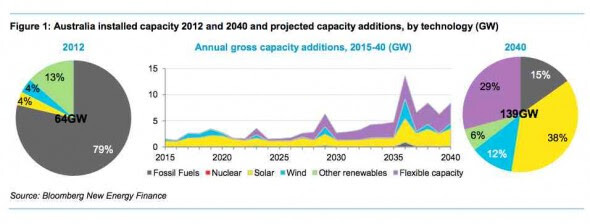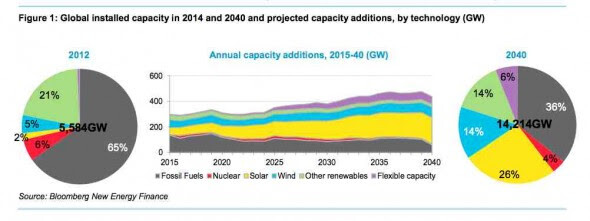A major new report from Bloomberg New Energy Finance has predicted that rooftop solar and battery storage will account for more than half of Australia’s electricity needs by 2040, as the share of fossil fuels falls by more than half to around 40 per cent.
BNEF says Australia’s power sector will fundamentally change over the next two decades, as households and businesses turn to rooftop solar and storage and utilities shift to renewables to replace ageing coal and gas plants.
It is part of a massive global shift, with more than $3 trillion being invested in small-scale solar and battery storage worldwide, as the global energy system becomes largely decentralised.
The report predicts more than 50 per cent of Australia’s generating capacity will be located “behind the meter” by 2040, meaning that consumers will become “pro-sumers”, generating and consuming their own electricity.
BNEF predicts 37GW of small-scale solar PV – mostly on rooftops – and 33GW of battery storage will be installed by then.
“This will be driven by the superior economics of these technologies, which will be able to supply consumers with electricity at a lower cost than the grid” said Kobad Bhavnagri, the Australian head of Bloomberg New Energy Finance and co-author of the Australian chapter of the report.
The BNEF predictions for Australia are part of a global trend that will see energy systems move from centralised to decentralised grids, including in developing nations.
Some $2.2 trillion is expected to be spent globally on small-scale solar, as capacity grows 17-fold to 1.8TW (that’s 1.8 million megawatts). But nearly half of this ($US1 trillion) will be in developing economies, in many cases bringing electricity to remote villages for the first time.
Bhavnagri also said any new large-scale capacity in Australia would be almost exclusively renewable, with large-scale solar PV (currently little more than 130MW) to reach 15,000MW, overtaking wind energy (now 3,500MW) which will be 13,000MW.
BNEF says these future large-scale solar projects will be lower in cost than building new coal or gas generators, even without subsidies.
© 2015 Solar Choice Pty Ltd

